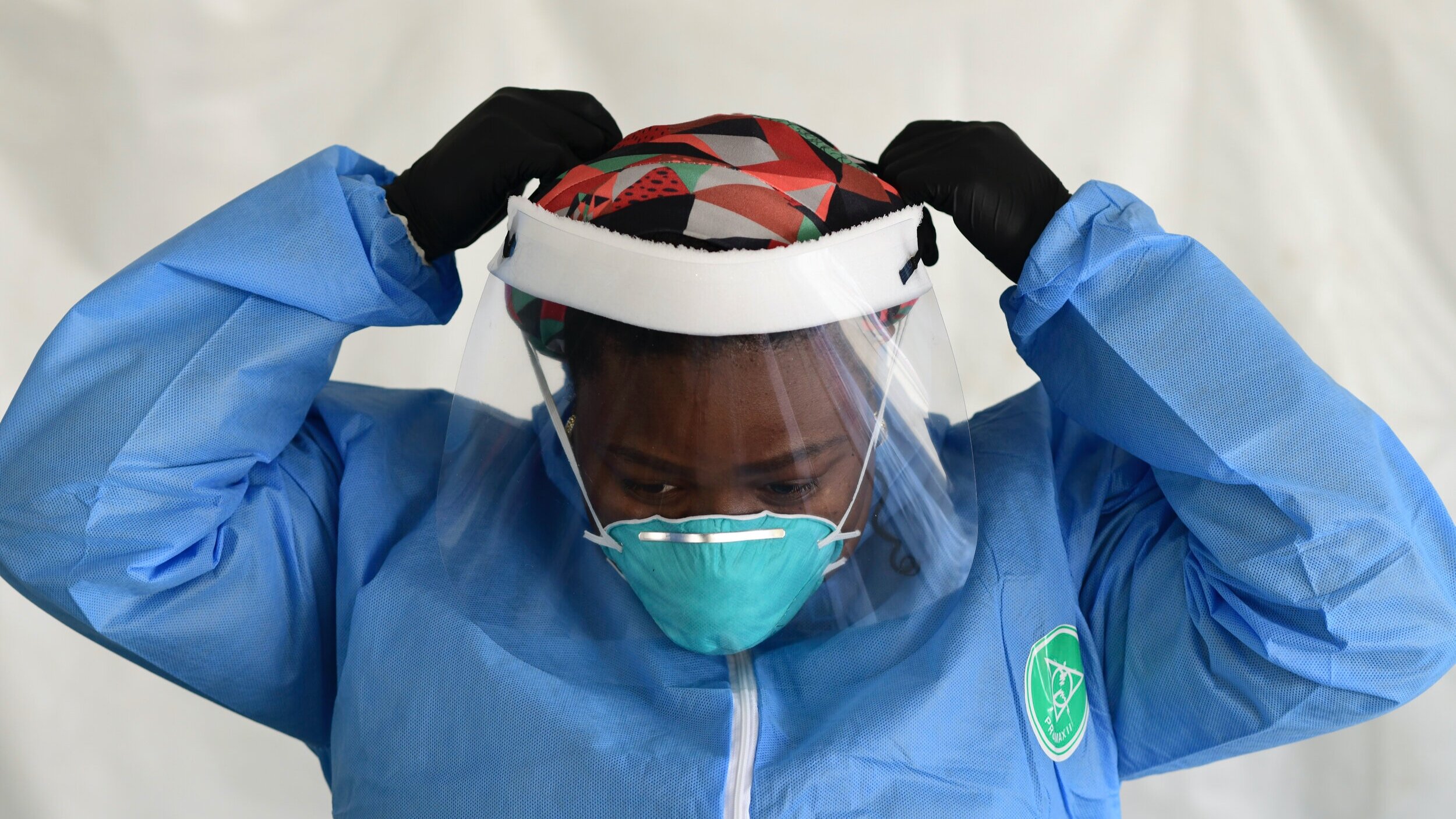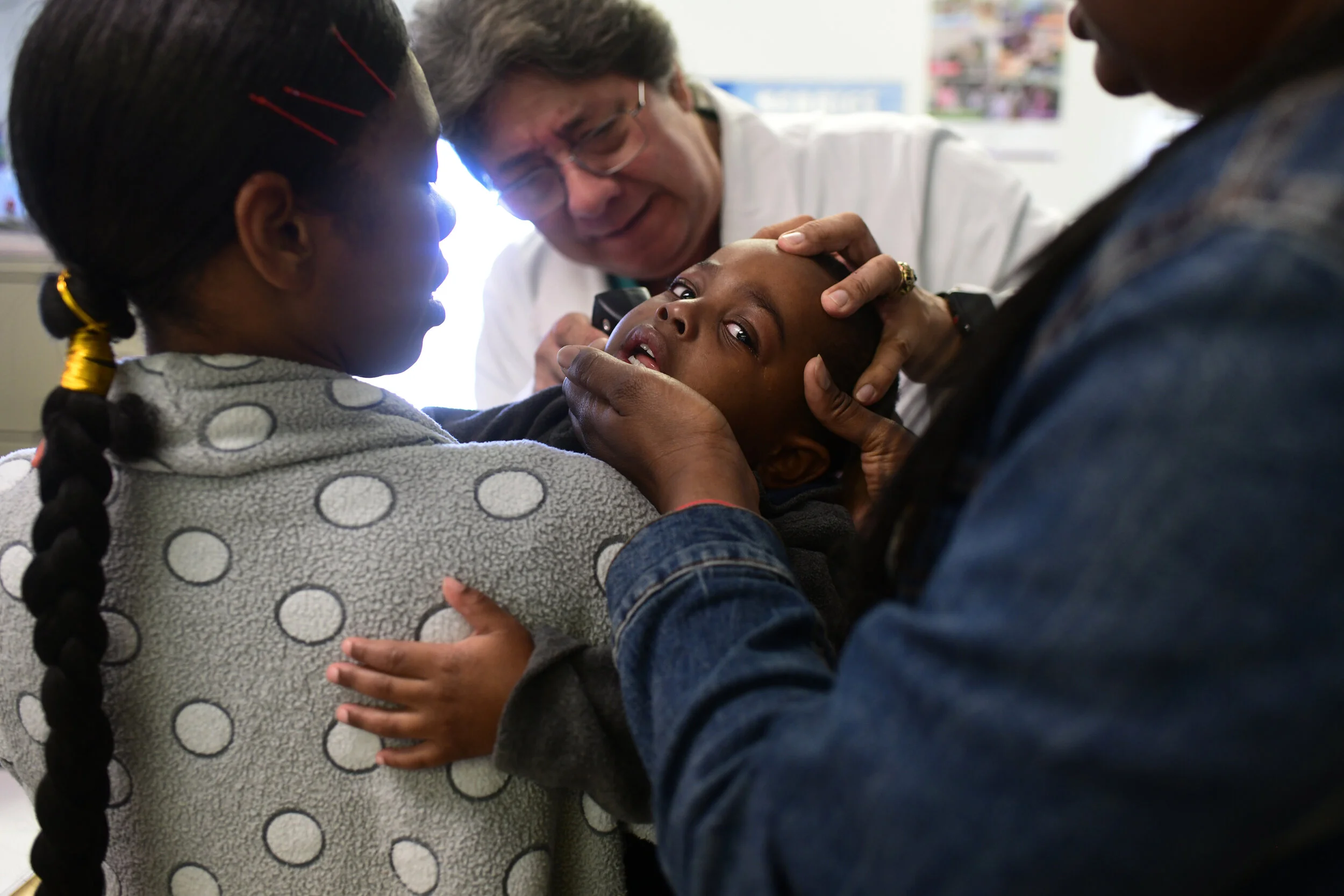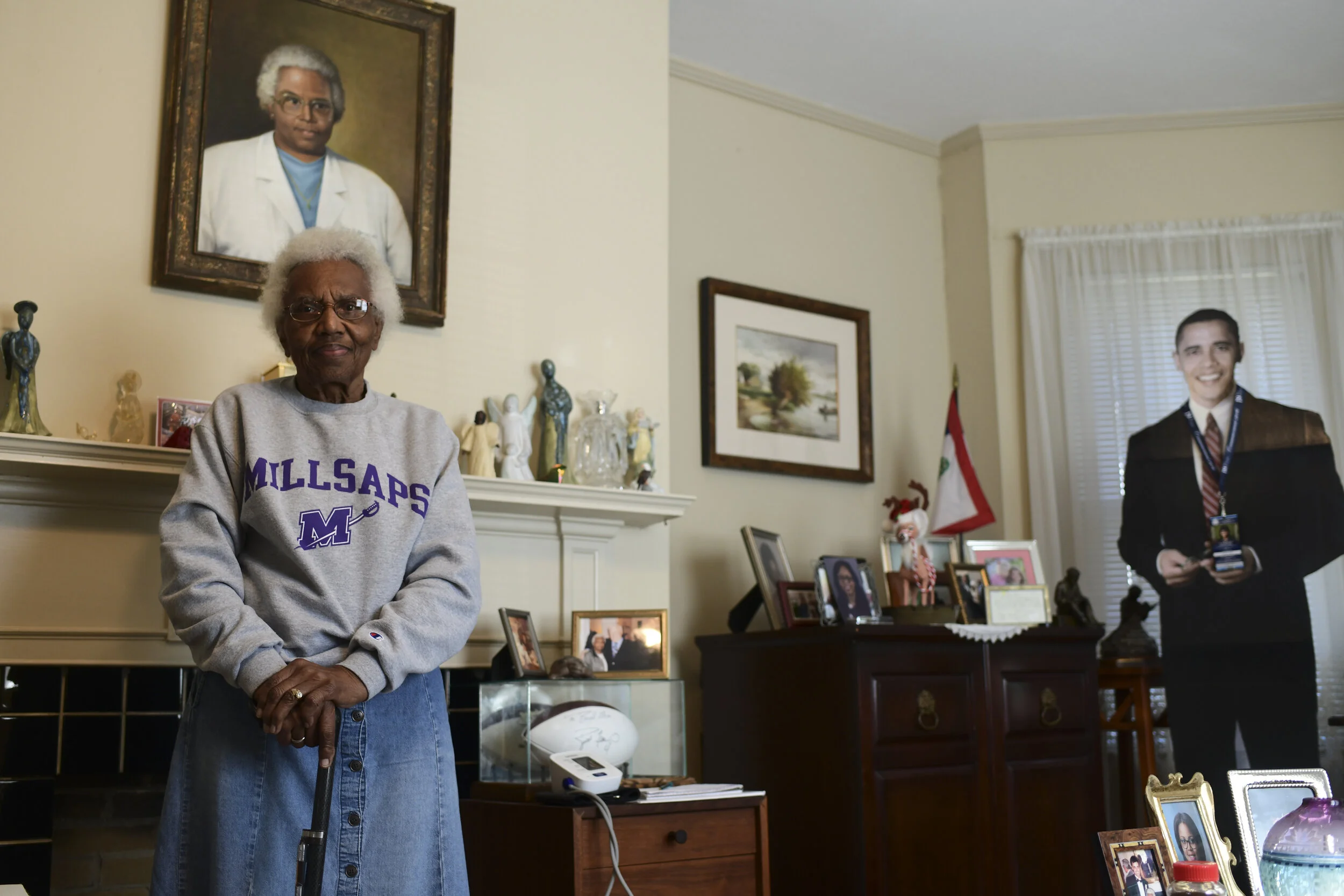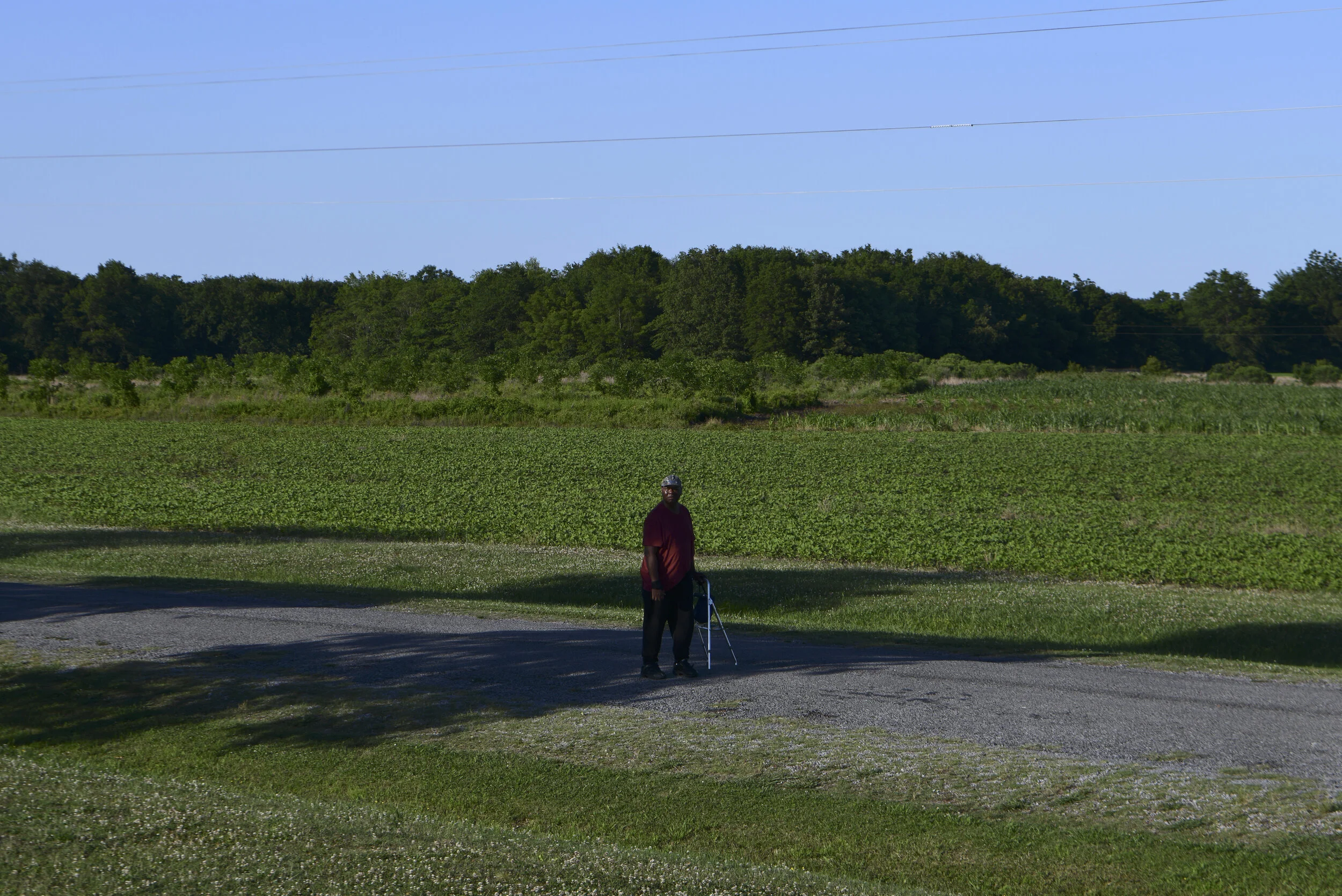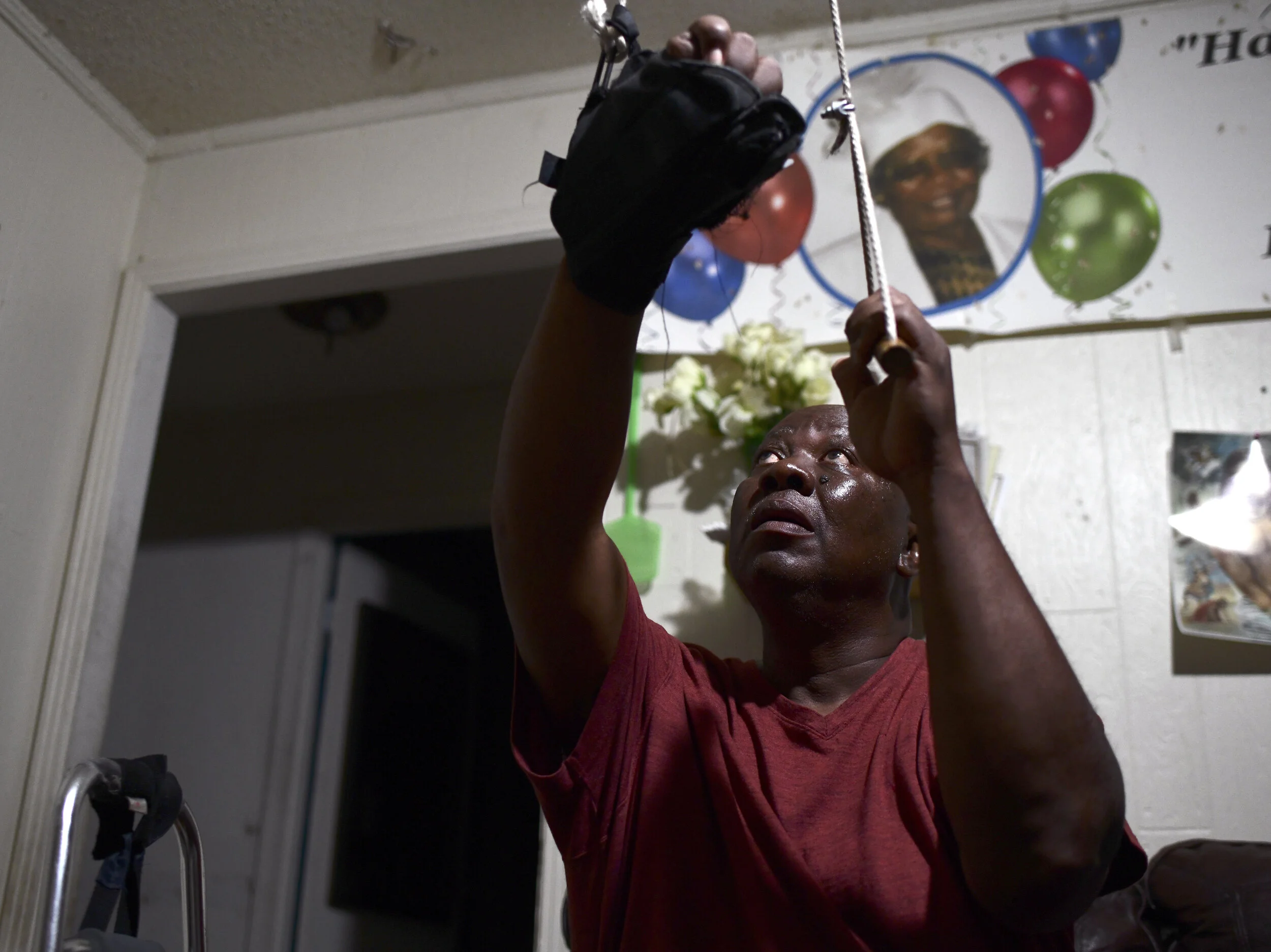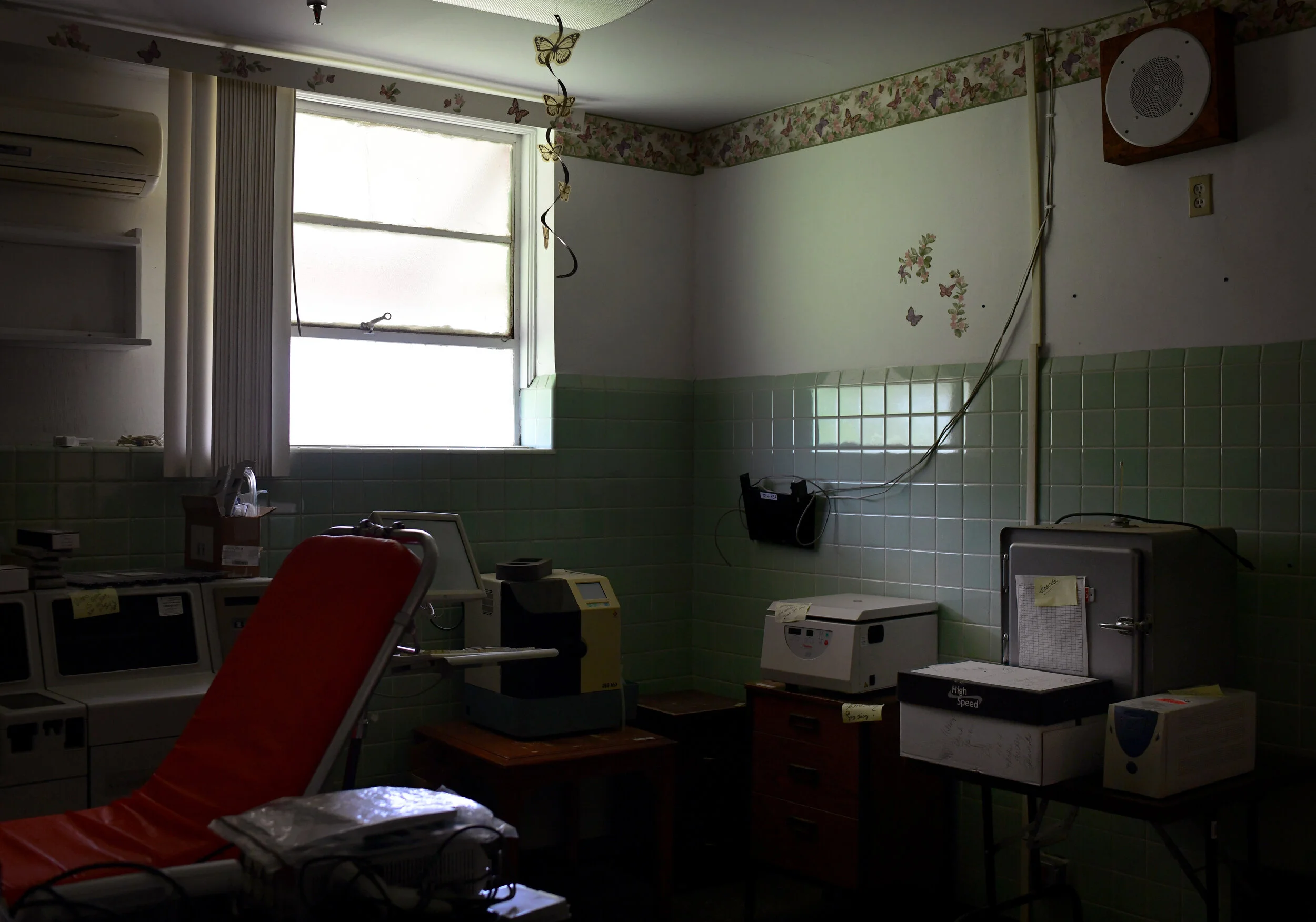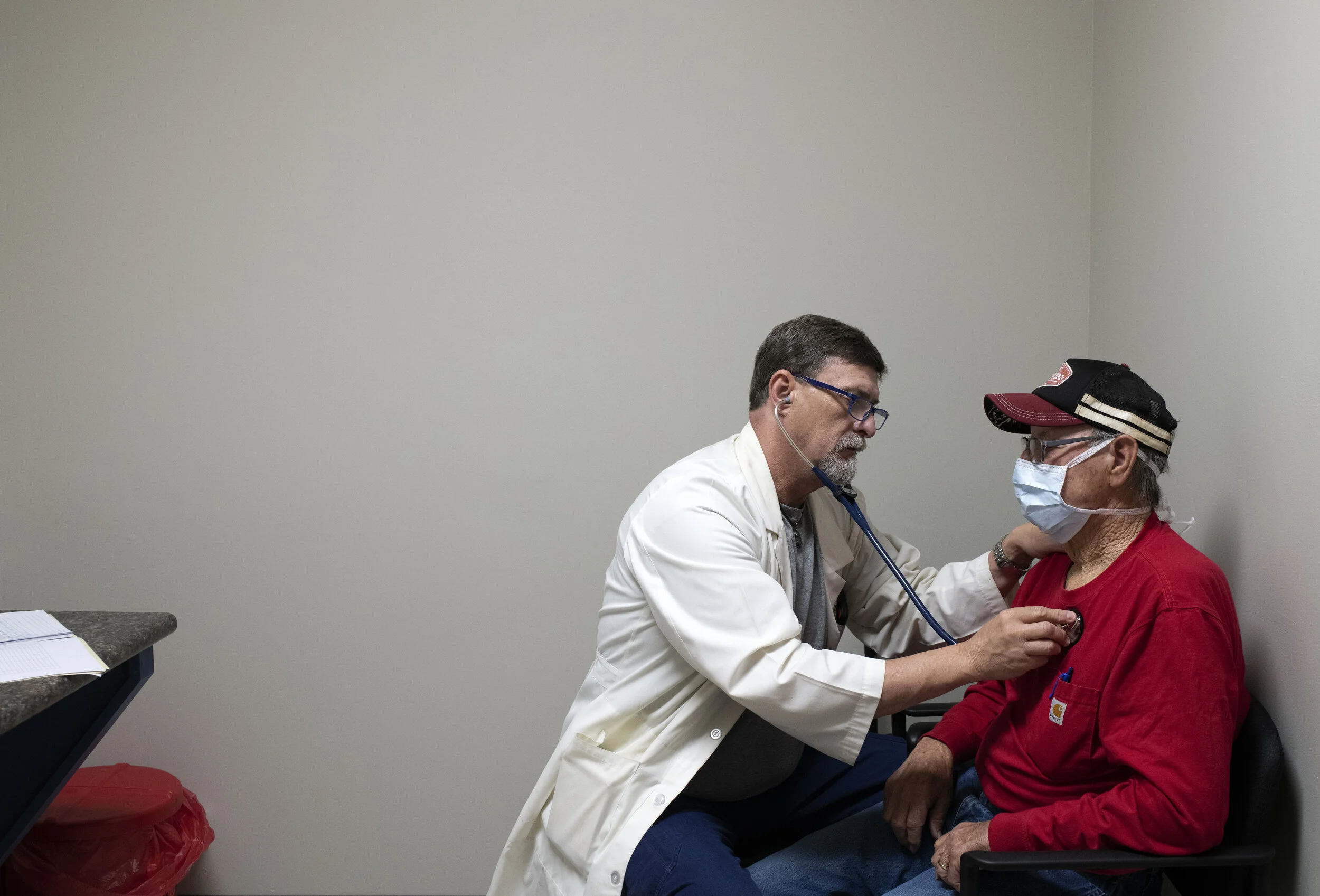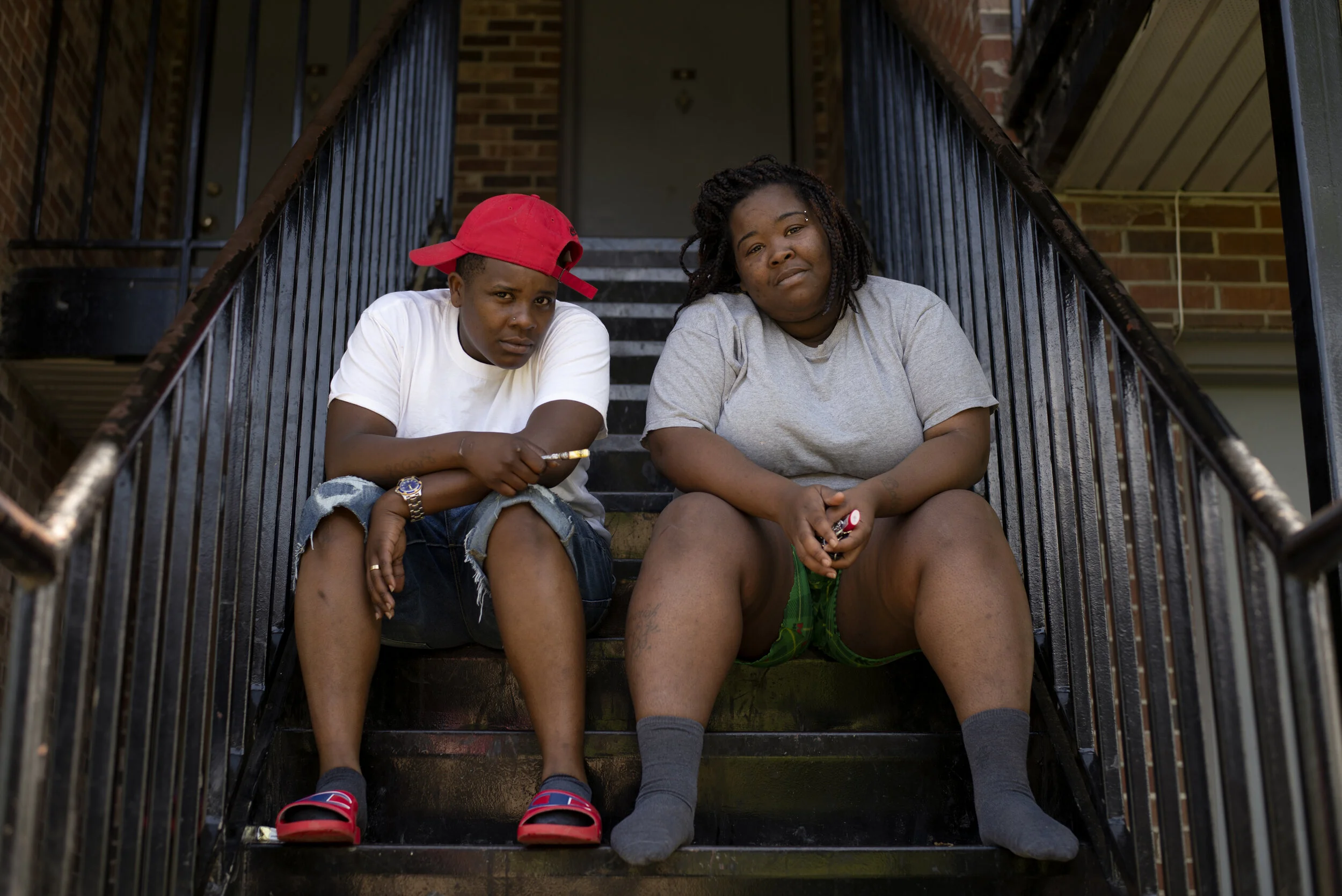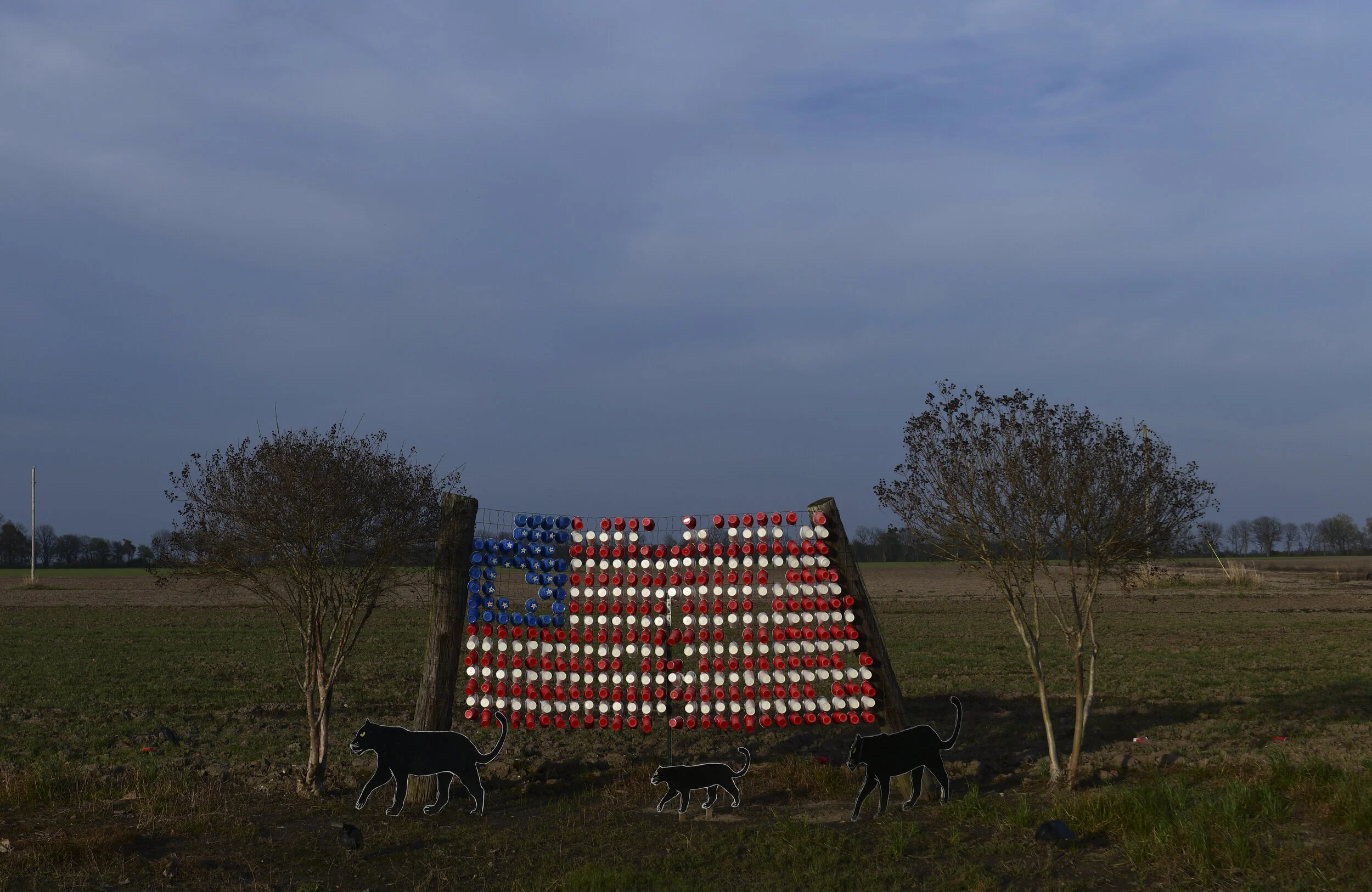Healthcare facilities in rural Mississippi have been fighting an uphill battle against financial hardships, closing facilities, a history of racial inequality, and dwindling populations long before the pandemic hit. Doctors, nurses, and caregivers press on because they want their patients — friends and neighbors they’ve known their whole lives — to live the healthiest lives possible.
Story & Photographs Jennifer Mosbrucker
Fog hung in the air as pink and purple hues reflected off water pooled in the crimped Mississippi Delta soil. Although most of her neighbors were still fast asleep, Dr. Marketta Blue’s feet hit the ground. It was 6 a.m on an April morning. By the time she returned home that evening, she rounded on two patients who’d been admitted to Bolivar Medical Center, the nearest hospital, then continued to Delta Health Center (DHC) where she saw another 28 patients in the clinic. She checked on her admitted patients throughout the day, and if it was a quiet night, she might’ve indulged in the luxury of uninterrupted sleep.
The days are long in primary care, but this is what she signed up for. Growing up in the Delta, Blue was one of four children raised by a single mother. Medicine seemed like a far-fetched dream for a younger version of herself. At the time, her family medicine cabinet consisted of two staples: Vicks VapoRub and castor oil.
Blue’s interest in medicine was sparked at age 10 when she began caring for her grandmother, who has heart disease. Her grandmother was educated up to the sixth grade, and Blue wanted to help her understand her condition and treatments. When she decided to become a doctor, she had one driving question: “How can I help other people understand what I didn't know, or what my grandmother didn't know,” she said. “That was always my task or my goal — to go and learn and come back and educate and help treat, and all of that.”
That’s precisely what she does each day at DHC, the nonprofit community health center in Mound Bayou, Mississippi, where Blue has worked since 2017. Driving along U.S. Highway 61 toward Memphis, a blink could cause you to miss the brick building where health outcomes are being transformed.
Dr. Marketta Blue rounds on her patient in the intensive care unit as nurse Taylor Watson takes notes on March 9, 2020, at Bolivar Medical Center. Blue is on-call at the hospital two weeks out of the month, rotating with another physician at Delta Health Center.
A sign on a nearby road proudly welcomes travelers to the town of just over 1,300, “The Oldest U.S. All Black Municipality.” Established in 1887 by formerly enslaved peoples, Mound Bayou was a haven from the oppression and segregation rampant throughout Mississippi. When DHC — originally named the Tufts-Delta Health Center — started seeing patients in 1965, many of the people it served lacked access to proper care. Some were living in sharecropper shacks without running water or sanitary privies.
The founding of the clinic, and the larger community health-center movement, is deeply tied to the civil rights movement. At a time when the color of a person’s skin dictated their access to health care facilities, activist and journalist-turned-physician Dr. H. Jack Geiger and his colleagues with the Medical Committee for Human Rights sought funding from the Office of Economic Opportunity (O.E.O.) to create two community health centers for vulnerable communities, one in the Columbia Point neighborhood in Boston, and the other in rural Mound Bayou.
Before selecting Mound Bayou as the location for a rural health center, community organizer John Hatch went to the Delta to live with sharecroppers and gauge the necessity and feasibility of the new health clinic. Geiger, who was white, and Hatch, who is Black, were met with apprehension from communities and stonewalled by legislators, but they nonetheless worked tirelessly to establish a rapport with skeptical residents who had few reasons to trust two outsiders. Gaining that trust required long conversations with local preachers and community leaders whose buy-in was critical.
As for the stubborn legislators, a partnership with Tufts University and a dedication from Count D. Gibson, the school’s chairman of the Department of Preventive Medicine, helped the organizers circumvent opposing politicians by allocating the O.E.O. funding to the university rather than the state of Mississippi.
Delta Health Center pediatrician Dr. J. Abraham Rodriguez checks King Coleman's ears as his mother, LaKourtney Giles, and health services worker Tisha Farmer hold him on Jan. 28, 2020, at Bolivar County Head Start Cleveland Center #2. During the free physical exams, about a dozen children had their vision and hearing tested, and those under 2 years old were given a hemoglobin test.
Before starting the clinic, Geiger called on Dr. Helen Barnes, the state’s first Black female obstetrician to join the staff. Barnes was barred from attending all-white medical schools in Mississippi, but she received a loan from the state to cover her medical schooling at Howard University.
She later began her career as a general practitioner in Greenwood, a Delta town 53 miles from Mound Bayou. During her four years there, she paid back a portion of the loan while working in the underserved community. At the time, she was told she was not allowed to treat white patients.
After wrapping up the days at her small clinic, she would return to the house where she rented a room to find patients lined up on the porch. Sharecroppers could seldom take time off to see their doctor, or take their child to be seen during clinic hours. Families could not afford to give up the $2 or $3 per day they made picking cotton. “The thing that you were never accustomed to though, is that your practice never stops,” Barnes said.
Dr. Helen Barnes, Mississippi's first Black female obstetrician, stands in her home on Dec. 3, 2019, in Jackson, Mississippi.
After civil rights activist Medgar Evers, a dear friend to Barnes, was killed in 1963, she left Mississippi for a residency program at Kings County Hospital in Brooklyn, New York. Although Barnes was apprehensive at first, Geiger convinced her to return to the Delta following her residency. DHC would provide comprehensive health care services that would have been difficult, if not impossible, to address as a private physician in Mississippi.
In a film produced in 1970 by Judy Schader Rogers, Barnes noted that the goal of the center was not based on medicine itself. “Medicine may be the way we got in the door, but medicine is not [the] number one priority,” Barnes said. “There are other priorities, and those priorities are food — number one — and then the way to make a living.”
The founders of DHC aimed to build a center that addressed all aspects of patient care. From a farming co-op where people could find work, to nutrition classes and training for nurse’s aide positions for town residents, they focused not only on treating the core contributing factors of each patient’s health, but also providing a way toward economic empowerment.
What started in Columbia Point and Mound Bayou sparked a community health-center movement that led to the birth of more than 1,400 facilities across the United States that currently receive funding through Section 330 of the Public Health Services Act. These clinics provide care to all patients regardless of their ability to pay. They also provide prescription medications at discounted rates, free vaccinations for underinsured children, and community resources.
Today, DHC medical staff care for more than 15,000 patients each year. The services include primary care visits, X-rays, dental care, mental health services, testing for sexually transmitted diseases, outreach events for families in low-income housing, a clinic for teenagers that teaches safe sex, a seasonal garden for patients to plant and take home fresh vegetables, a Type 2 diabetes prevention class, physical therapy, and a wellness center where all patients can exercise for free.
Despite the intensive approach, providers at DHC and throughout the state still fight an uphill battle. Many of the issues their patients face are systemic, and not all rural Mississippians have easy access to a community health center. Culture, educational opportunities, employment, access to health insurance, nutrition, and generational poverty all play a role in determining the health of an individual.
Since the data was first collected 30 years ago, Mississippi has ranked in the bottom three states for overall health outcomes, according to America’s Health Rankings. The state ranks highest on the economic hardship index, and it has among the highest rates of diabetes, cardiovascular disease, and obesity. The rates for uninsured and underinsured individuals are also among the highest in the country.
The 2015 Mississippi State Rural Health Plan detailed the challenges of the current rural health system, but the state’s health department failed to identify actionable steps to achieve better outcomes.
Dr. Marketta Blue and nurse Ashley Jones visit with David Breaux, his wife, Darlene Breaux, and their granddaughter, Pixie Breaux, age 3, before administering a vaccine prior to his mission trip on Feb. 19, 2020, at Delta Health Center. Breaux was their final patient after a long day at the clinic.
In 2019, a rural health task force established by previous Governor Phil Bryant released a report in which the committee reanalyzed challenges faced by rural health facilities and gave suggestions for how best to move forward. By early 2020, many facilities were too overwhelmed by COVID-19 to implement new strategies.
For rural hospitals and clinics that don’t receive funding from the Public Health Services Act, providers are limited in services they can offer patients.
To understand why the needle has been difficult to move is to understand the social determinants of health DHC continues to tackle. Managing complex medical conditions such as heart disease and diabetes can be especially difficult for some of Blue’s patients. A lack of health literacy, barriers to accessing nutritious foods, a lack of transportation to appointments, and limited incomes often determine a patient’s disease progression.
Much of Blue’s time is spent educating patients rather than simply diagnosing and prescribing treatments. “I ask them, ‘What are the names of the medicines that you're on?’ They can't recall them. And I said, ‘Well why can't you recall the name of the medicines you're on? It’s right here on the bottle.’ You figure out half of them can't read,” she said.
As patients arrive with their medications, she takes the time to write abbreviations on the bottles so that patients can quickly remember which pills are for each of their conditions. “It’s more than prescribing medicine,” she said. “It’s so much more than that.”
In 2018, Orlando Morton was doing maintenance work outdoors for an apartment complex in Cleveland, Mississippi, when he experienced a stroke that left him paralyzed on the right side of his body. For the first time in his life, Morton required extensive health care services. After visiting the emergency room in town, he was transferred to a hospital in Jackson, Mississippi, for further treatment.
“They called an ambulance to take me to Jackson. That's all I know. They put me in some kind of time machine, an MRI. They had me stretched out. Had my head shaking, rattling around,” Morton recalled.
While in Jackson, Morton went through extensive physical therapy to be able to move the right side of his body. With two people at each side of him, a person in front and one behind, they tried to reteach his body how to walk. “I didn't see it doing any good, but I kept going. Then I went back to my room, ate, and went to bed. Tried to sleep,” he said. “That was my first time being in the hospital, though. 63 years old. I did pretty good staying out of the hospital a long time.”
Once released from the hospital, Morton’s brother drove to Jackson to pick him up and bring him back to Shelby, Mississippi. He remained in a wheelchair for a month, unable to move well enough to function independently. Receiving only $300 per month for disability and $550 for Social Security, Morton was cautious with his finances as he moved back into his mother’s house to recover.
While visiting with a neighbor one afternoon, he was told about a physical therapy program offered at Bolivar Medical Center in Cleveland, a community of approximately 11,600. Were it not for that conversation, Morton believes he would still be sitting at home in a wheelchair. He did not know that the services would be available to him. After Medicaid paid its portion of the treatment, he recalls seeing a bill for about $30.
His brother, Tyrone, made the 20-minute drive with him to each appointment. “Sometimes he would wait. I'd be praying to get better because I wanted to take myself. People got things to do. That's a job, taking people places,” Morton said.
Morton spent one month in therapy at the hospital before he could finally walk on his own with a walker. Since then, he has spent most mornings at DHC in the Wellness Center. For several hours each day, he moves from one machine to the next, securing his right hand to the workout equipment, willing his nerves to remember how to function.
Orlando Morton often walks around a lake in Bolivar County near Mound Bayou, Mississippi, to regain strength from a stroke he had in 2018. After receiving treatment in Jackson, Mississippi, he came home to the Delta where he received physical therapy at Bolivar Medical Center and Delta Health Center. When he tires of walking, he sits in his car and listens to Mississippi Public Broadcasting.
Earlier last year, the health center got its first physical therapist, who now sees Morton twice a week in the Wellness Center. Because the facility is federally funded, the fear of wracking up medical bills isn’t a reason for patients to avoid seeing their providers. Everyone has access to treatment, regardless of their ability to pay. For many in the Delta, this is critical in preventing complications from chronic medical conditions.
Little by little, Morton is regaining strength in his right arm. He is now able to drive himself to get groceries, as well as to get to church on Sundays — something he says has carried him through this trial. “I didn't want to be handicapped. Don't want people to wait on me. I try to be independent. My hand stays hot all the time — that's a good sign. My nerves are waking up."
Orlando Morton exercises his right hand and arm using a pulley system his brother created by hammering nails through a leather waist belt in the ceiling at his home in Shelby, Mississippi.
Orlando Morton grabs a few oranges at the grocery store on Feb. 7, 2020, in Cleveland, Mississippi. It takes about 20 minutes to drive to the store from his home in Shelby, Mississippi, something he could not do on his own after his stroke. It took months of rehabilitation before he was able to drive.
Without the emergency services and physical therapy he was able to access at Bolivar Medical Center, Morton may have had wildly different health outcomes following the stroke. Just as Morton was regaining his strength early last year, the facility made headlines after a report was published stating nearly half of Mississippi’s rural hospitals, Bolivar Medical Center included, were at risk of closure due to finances. Navigant, a health consulting firm, determined this by looking at the hospitals’ total operating profit margin, days cash on hand, and debt-to-capitalization ratio. Its study concluded that 31 of the state’s 64 rural hospitals were at risk of closure, the highest proportion of any state.
Five years prior and 81 miles southeast of Cleveland, a community had already closed its only hospital, and they were forced to reimagine what care would look like in the area.
Mint green tiles still line the walls of the vacant emergency room at Kilmichael Family Medical Clinic; a sort of time capsule for the opening of the facility as a hospital in 1955. The shiny new building in Kilmichael consisted of a doctor’s office, two examination rooms, nine inpatient beds, a small laboratory, an X-ray machine, a sterile supply room, a dietary department, and a surgical room that doubled as a delivery room.
As with other rural hospitals, the passage of the bipartisan Hill-Burton Act in 1946 made the construction of the building possible, and a $20,000 bond issued by the county sealed the deal. The brick facade looks a little worn, but several years ago, the main ward of the hospital that has been converted to a clinic was completely remodeled.
In 1995, Sandra Oswalt was between nurse practitioner jobs and had just opened a weight-loss business in Kosciusko, Mississippi, when she met L.C. Henson, a doctor at Kilmichael Hospital, during a continuing education course. Having learned of him before the meeting, she decided to introduce herself.
“I hear that you work 24 hours a day, seven days a week, and you may need some help over there in Kilmichael,” she said. Henson said he would think about it. “That was on a Saturday. On Monday they called me and asked if I would come to work.”
Lab technician Myra King, who has worked in the facility off and on since 1981, can remember those days when the hospital was bustling. “Back in the day, we had them [patients] lined up in the hallway. Beds were even in the hallway,” she said.
Kilmichael Hospital opened in 1955 and closed in 2015. The emergency room, seen here, was financially draining for the facility and was terminated a few years prior to the closing of the hospital. It is now used as a storage room for Kilmichael Family Medical Clinic, the current health service using the property.
As health care costs mounted over time, the hospital began losing money. First, it stopped delivering babies, then it closed the emergency department. In 2015, Kilmichael Hospital made the difficult decision to close its doors. Throughout rural Mississippi, and across rural America, many small hospitals have been facing similar fates. The financial burdens put on small, local hospitals have continued to mount, while Medicaid reimbursement rates and regulations have tightened.
“All small hospitals in Mississippi went through this problem of not being able to get reimbursement that would actually pay for the admissions,” Oswalt said. “Medicare was the big runner for cutting the amount of funds you would get for any one said admission. If you didn’t get that patient completely well, it seemed like when they went home and came back, you got no money for a re-do. Whether you were or were not responsible for their ability to get well, you got no money for that [readmission]. After a while, you can’t survive in that kind of climate of no reimbursement.”
After closing, the hospital was repurposed as a clinic run by Greenwood Leflore Hospital for several years before that clinic moved to a building across the street. It then sat empty for a while before North Mississippi Health Services opened Kilmichael Family Medical Clinic, which is still operating.
Darren Butts has lived in Kilmichael, Mississippi, all his life and only remembers going to Kilmichael Hospital when he was electrocuted at 3 years old. For most of his life, his family has driven 15 minutes to Winona for check-ups and emergency medical treatment. A few years after the local hospital closed, Kilmichael Family Medical Clinic opened in the old facility.
The town of Marks, Mississippi, just 1 1/2 hours northwest, similarly lost its hospital in 2016. The closing of Quitman County Hospital in Marks, with a population of approximately 1,700, looked much like the one in Kilmichael. The emergency department was hemorrhaging money as reimbursement from Medicaid dwindled.
“The ER was probably the worst financial problem to the hospital,” said Lonnie Moore, a family nurse practitioner at Family Medical Clinic in Marks, who used to work in the hospital’s emergency department. “It’s probably what ultimately brought the hospital down.”
The health care needs of patients in rural communities have shifted since the construction of their hospitals in the mid-20th century. The concept of “rightsizing” a facility is something Ryan Kelly, executive director of the Mississippi Rural Health Association, has been advocating for. “One of the many things we're looking at is how do we right-size the amount of care in a community, which may mean growing, may mean shrinking,” he said. “That’s kind of difficult.”
For Kilmichael and Marks, where employment opportunities are slim, hospital closure was devastating for those who struggled to find other opportunities within the towns they’d long called home. “The hospital closing affected the community because the hospital was the largest employer in the county at one time,” Moore said of Marks.
Pictures of family and friends are posted on a cork board lining the hall at Family Medical Center in Marks, Mississippi. The clinic is the only available health care service in the area after Quitman County Hospital closed in 2016 due to finances.
Despite having worked at Kilmichael Hospital for years, Oswalt doesn’t think reopening the hospital would be realistic, even if it were fully reimbursed by Medicaid and Medicare. “I would think that money would need to go to the Critical Access Hospital and build it up further,” she said. The town’s population of under 600 people, approximately 80% of whom she said are publicly insured, cannot support a hospital of its own.
With Tyler Holmes Memorial Hospital 11 miles away in neighboring Winona, patients with transportation can easily access care within a drivable distance. The facility is designated a “Critical Access Hospital,” and therefore receives federal funding to help with operating costs. To receive this classification, hospitals must be more than 35 miles from another hospital, provide emergency medical services, and have 25 or fewer acute care inpatient beds, with an average annual inpatient stay of 96 hours or less.
In exchange for meeting these requirements, Critical Access Hospitals would previously receive 101% reimbursement for caring for Medicaid and Medicare patients. Since these facilities serve a large number of publicly insured people, this level of reimbursement was set to keep hospitals open in areas where access is slim for vulnerable populations. In 2011, everything changed. The Budget Control Act passed by Congress stated 2% of all Medicare provider payments after April 1, 2013, would be withheld.
For Quitman County Hospital, which had received the C.A.H. designation, the federal requirements further contributed to the hospital’s demise.
“The problem is we have a lot of people who are politicians who don’t realize the second, third, and fourth-order effects of the decisions they make. Because of everything — the Affordable Care Act — because of all that, look at how many rural hospitals have closed,” Moore said. “Now all these people here don’t have a hospital anymore, they don’t have an ER to go to because of government regulations. You can’t keep a hospital open when it’s losing a million a year.”
A perceived higher quality of care in urban areas, as well as a need for specialized physicians, often drives privately insured patients to seek care outside of their local community. This “out-migration” of services means rural hospitals rely even more heavily on Medicaid and Medicare reimbursement.
The coronavirus pandemic has shown that hospitals are not the only financially vulnerable health care service. Kilmichael Family Medical Clinic was forced to furlough several workers at the onset of the pandemic, and the rural health clinic across the street was permanently closed. For months, patients across the country put off preventative care visits out of fear of contracting the virus. The loss in revenue was palpable.
April showers saturated the fields throughout Issaquena County, and the land had just begun to dry out. Farmers were once again tilling the soil thanks to the newfound sunshine. While much of the world was hunkering down to slow the spread of the global pandemic, life in Issaquena remained largely unchanged.
The nearby country store that usually served lunch shut its doors for the time being, and George Mahalitc began slathering mayonnaise on Wonder bread as he prepared bologna sandwiches for the 15 farmhands working in his fields. “Besides the store closing, life hasn’t changed much,” he said. “We’re spread apart anyway and distance helps.” Despite the spreading virus, there was work to be done.
Down the road in nearby Mayersville, the only health facility within the county, an outreach clinic run by Delta Health Center, had temporarily closed. For the approximately 1,300 folks in Issaquena, the closest place to get tested for COVID-19 was Rolling Fork, Mississippi, where there’s a county hospital funded by both Sharkey and Issaquena Counties and a couple of rural medical clinics.
George Mahalitc makes bologna sandwiches for the 15 workers on his 12,000-acre farm on April 10, 2020, in Issaquena County, Mississippi. The nearby country store where his workers usually eat lunch closed to prevent the spread of COVID-19. Work on the farm did not slow down, despite the pandemic.
Across the street from Sharkey-Issaquena Community Hospital and Nursing Home, nurse practitioners Jennifer and Tommy Scott opened Rolling Fork Medical Clinic in October 2019. Both grew up in town and began working in health care during their teenage years. Tommy drove ambulances and Jennifer worked as a ward clerk at Delta Regional Medical Center. The couple married and started their family before going back to school at Delta State University to become nurse practitioners.
“I’m taking care of folks I’ve known my whole life,” Tommy said last spring. “They helped raise us.” The thought of leaving the Delta hadn't crossed their minds.
When the pandemic first hit, community members rallied behind their health care workers and brought them masks. In April, the clinic began testing patients through a company that could provide results within 24 hours, days before the hospital was able to receive results.
Family nurse practitioner Tommy Scott listens to Roger Heigle's heart on April 16, 2020, at Rolling Fork Medical Clinic in Rolling Fork, Mississippi. Heigle came into the clinic with a common cold, what Scott referred to as “the Delta crud.”
Early on, local compliance to social distancing measures was a constant struggle. “Six o’clock when the farmers stop and everything shuts down, the Double Quick looks like it always has; 20, 30 folks in there grabbing beer and chicken,” Tommy said. A yard sign placed by a stop sign not far from the clinic read “there is no virus” and “expose 5G.”
Worse than widespread skepticism was the lack of support the hospital had to deal with critical coronavirus cases. With only two ventilators, it wouldn't take much to overwhelm the local hospital.
In July, Tommy died in an accident, and Jennifer was left to care for a clinic full of patients on her own. Losing Tommy didn't just affect patient care. In a town of just over 2,000, he was more than a primary care provider. His patients knew him as a friend and neighbor. Even though he was a nurse practitioner, folks would call him "Doc Tommy" whenever they saw him.
In December, the two physicians who owned the clinic decided to close it due to finances. Jennifer is working to reopen under new ownership so she can continue to care for her patients. In the meantime, they have had to seek care elsewhere.
Sherie Bailey, left, and Keiundra Walker pose for a portrait while watching their children play outside of Twin Oaks Apartments on April 9, 2020, in Mayersville, Mississippi. Walker received a notice from the landlord of the complex stating that residents were not allowed to have visitors due to COVID-19. Walker is a home health aide who does not have personal protective equipment to use while entering residents' homes. She was informed by her employer that she would have to provide the equipment herself.
Delta Health Center’s work hasn’t slowed down over the last year either. In the sweltering summer heat, Blue suited up for DHC’s drive-thru COVID-19 testing sites in various Delta hamlets. Together, the health care team at the center administered over 10,000 tests. With the focus shifting to vaccinations, she says there are more patients who would like to receive their two doses than are being made available to the clinic.
In contrast to recent reports that Black Americans are hesitant to get the vaccine due to an underlying lack of trust in the scientific community, DHC’s chief program planning and development officer Robin Boyles says 85% of the 825 vaccines administered have been to Black patients.
With coronavirus testing, vaccinations, routine health visits, and inpatient care at the hospital, there have been days when Blue has seen 60, 81, and 126 patients. With many of these patients out of work and isolated from family and friends, some have come to her office just to feel seen and know they are not alone in their grief.
“I had a patient last week that just wanted to come in for me to console him because he’d just lost his mother, and then his girlfriend lost her mother,” she said. “He said he didn’t know how to be strong for her because he was hurting.”
As she drives home each night after hours of tending to patients and being their listening ear, Blue finds her support in her inspiration — her grandmother. Each night as they “catch up on the day” she recharges to find the strength to do it all over again, knowing she’ll have a clinic full of patients who need her in the morning.
A solo cup American flag leans along U.S. Highway 61 in Panther Burn, Mississippi, an unincorporated Delta town.
Jennifer Mosbrucker is a freelance photojournalist and picture editor based in Eastern Washington. She is a frequent contributing photo editor at The New York Times and previously worked as a staff photographer for The Commercial Dispatch and The Columbia Missourian. Mosbrucker spent a year in Mississippi meeting doctors, patients, and healthcare workers with one goal: To tell the story of rural healthcare in the state.

